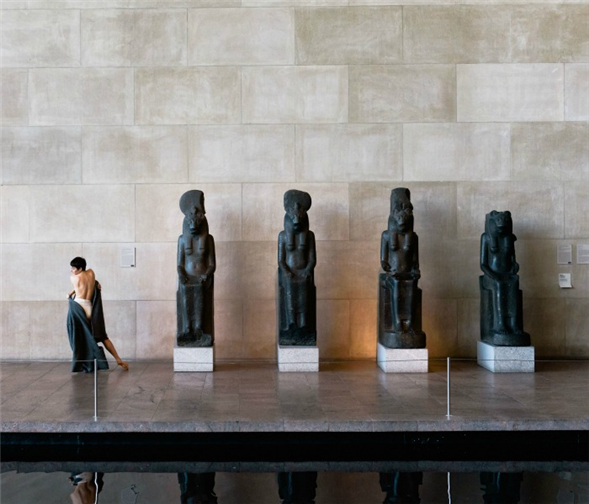Translate Page

Andrea Miller's Gallim Dance company performs in the Met Breuer this month
---
On an unseasonably gray afternoon earlier this month, I was one of a handful of visitors wandering the Met Breuer galleries, and the melancholy outside seemed to have seeped into the space. But, once I reached the fifth floor, the mood lifted dramatically. There in a square room, Andrea Miller, the Met's first-ever choreographer artist in residence, strode between small clumps of dancers as they worked on (C)arbon, the site-specific piece her company Gallim Dance premieres this Friday.
In preparation for that debut, Miller is hosting open rehearsals so audiences can get a peek at her creative process. During the session I attended, I watched as two men lifted a woman upside down to walk the sides and then ceiling of a doorway. As she descended, she tucked into a ball and the men carried her like a chestnut nestled between two branches. Miller approached, suggesting a tighter shape. Then the choreographer continued to move around the room, interacting with her performers, her own dance in motion. As they worked, the walls were lined with observers, mostly art lovers who stumbled upon the scene. Some sat in odd positions, as if the movement was so fascinating they couldn't spend even one second to readjust.
For Miller, the chance to move beyond the traditional dance world was one of the big attractions of this Met residency. "I'm more and more interested in adding relationships with collaborators and crossing mediums, as well as adding new applications in terms of where work can be and how it's delivered: in museums or on film, along with technology and photography," she says. "The world's becoming more interconnected, and whether or not that's positive, there's a new sort of need for stimulation. I feel it too, and I want to respond to that. What I'm working on is a conversation not limited to the dance world, but part of a larger dialogue. To authentically do that, I have to put myself in front of non-dance audiences in non-dance spaces, like the Met Breuer."
{Image1}
(C)arbon is Miller's second work in her Met residency. (Her first, Stone Skipping, was performed at the Temple of Dendur last October.) Presented in conjunction with the exhibition Like Life: Sculpture, Color, and the Body, and in collaboration with filmmaker Ben Stamper, (C)arbon consists of three half-hour pieces (a solo, a duet and a trio) that take place concurrently in three different galleries. Audiences can watch them in any order, just catch one or two, or opt to see one multiple times since the dancers rotate. "Since it's new individuals performing it, that specificity of the dancer's body, choices and movement is what you end up really experiencing," says Miller. "Because you sort of know the choreography -- it's a kick there, a turn there -- you watch the person instead."
Of course there are unusual challenges performing a work in this way. But the dancers "saw it as an interesting and exciting opportunity, since they have to embody what it is to be an individual, be present as a partner in duet and be open to the collective," says Miller. "Their own experience of that transition is built into the work -- the dancers will actually confront those differences. It's a real, authentic shift we get to see."
The disparate sections also encapsulate the theme. "We're exploring the body," she says. "But since that's a big topic, I've narrowed it down to the body's experience in three different states: as an individual; in a dual relationship like parent/child or siblings or lover/foe; and in the collective en masse."
Despite the unconventional setting, Miller approached the creation of (C)arbon her usual way, which she's honed over two decades as a dancer and ten years at the helm of Gallim. She and her team spend lots of time talking, collaborating and reworking movement. She initiates some sequences; her dancers develop others. Then they start digging into sections, further shaping and tweaking, continuing the "research" with her feedback. "When they have something that's like clay that's been molded, that's when I take it, tear it apart and work on it," says Miller. "I ask them to begin putting ideas into their bodies, muscles, imagination and skin, and I take it from there. We give the baton back and forth."
{Image2}
Admittedly the open rehearsals have added another layer to the process. While the dancers have the space to themselves in the morning, strangers dropping by to watch in the afternoon is complicated. "Having an audience early on allows us to understand what's legible even sooner," Miller admits. However, "I really don't like the feeling of having to think in front of people. There's the pressure of having to look like you know what you're doing. But the truth is, a lot of it is you don't know what you're doing."
Yet Miller says that it's worth those moments of discomfort to be able to bring dance to the museum. "The Met is a home for art," she says. "Dance and movement and performance are fundamental parts of that. So it's critical that this kind of work -- living work -- is represented and explored inside these walls."
---
Lauren Phoenix Kay regularly contributes to TDF Stages.
Photos by Charissa Fay, as a part of Gallim's photo shoot in partnership with #CamerasandDancers at the Metropolitan Museum of Art.
TDF MEMBERS: Go here to browse our latest discounts for dance, theatre, and concerts.